0 引言
表1 研究区3种典型断背斜构造样式的代表性气藏及不同部位岩石力学参数Table 1 Typical gas reservoirs and mechanical parameters of the different parts of the three typical fault anticlines in the study area |
| 构造样式 | 单元类型 | 代表气藏 | 杨氏模量/GPa | 泊松比 |
|---|---|---|---|---|
| 两断式平缓褶皱 | 断层部位 | 克深2、克深6、克深8气藏 | 15 | 0.22 |
| 背斜部位 | 10 | 0.24 | ||
| 二级反冲构造 | 断层部位 | 克拉2气藏 | 18 | 0.22 |
| 背斜部位 | 14 | 0.25 | ||
| 凸型三角带 | 断层部位 | 克深9气藏 | 18 | 0.24 |
| 背斜部位 | 14 | 0.26 |
1 区域地质概况
图2 克拉苏构造带克深地区典型构造样式地震剖面及对应3种典型断背斜构造样式力学模型[图2(a)和图2(b)据侯贵廷等[25]修改](a)过克深201井地震剖面;(b)过克深902井地震剖面;(c)两断式平缓褶皱力学模型图; (d)二级反冲构造力学模型图;(e)凸型三角带力学模型图(E为杨氏模量,u为泊松比) Fig.2 Seismic sections of subsalt structural styles of Keshen section in Kelasu tectonic belt and mechanical models of the three typical fault anticlines (Fig.2(a) and Fig.2(b) are modified from HOU et al.[25]) |
2 天然裂缝预测研究方法
3 3种典型断背斜天然裂缝分布特征
3.1 不同断背斜天然裂缝分布特征
3.2 断背斜不同部位天然裂缝分布特征
3.3 不同翼间角对断背斜天然裂缝分布的影响
图6 3种典型断背斜不同翼间角裂缝密度分布(a)两断式平缓褶皱130°翼间角;(b)两断式平缓褶皱140°翼间角;(c)两断式平缓褶皱150°翼间角;(d)两断式平缓褶皱160°翼间角;(e)二级反冲构造130°翼间角;(f)二级反冲构造140°翼间角;(g)二级反冲构造150°翼间角;(h)二级反冲构造160°翼间角;(i)凸型三角带130°翼间角;(j)凸型三角带140°翼间角;(k)凸型三角带150°翼间角;(l)凸型三角带160°翼间角 Fig.6 Fracture intensity distributions of the three typical faulted anticlines with different interlimb angles |
图7 3种典型断背斜不同部位厚度占比与距轴部的相对距离的关系(a)两断式平缓褶皱顶部区域;(b)二级反冲构造顶部区域;(c)凸型三角带顶部区域;(d)两断式平缓褶皱中部区域;(e)二级反冲构造中部区域;(f)凸型三角带中部区域;(g)两断式平缓褶皱底部区域;(h)二级反冲构造底部区域;(i)凸型三角带底部区域 Fig.7 The relationship between thickness ratio of different parts of the three typical fault anticlines and relative distance to the axis |











 甘公网安备 62010202000678号
甘公网安备 62010202000678号